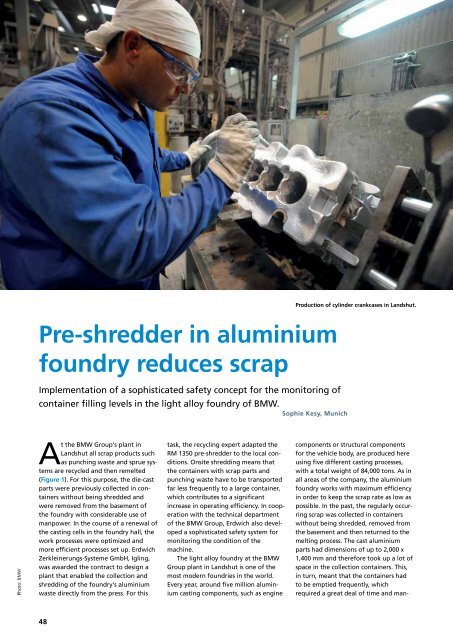CPT International 01/2019
Create successful ePaper yourself
Turn your PDF publications into a flip-book with our unique Google optimized e-Paper software.
Pre-shredder in aluminium<br />
foundry reduces scrap<br />
Implementation of a sophisticated safety concept for the monitoring of<br />
container filling levels in the light alloy foundry of BMW.<br />
Production of cylinder crankcases in Landshut.<br />
Sophie Kesy, Munich<br />
Photo: BMW<br />
At the BMW Group‘s plant in<br />
Landshut all scrap products such<br />
as punching waste and sprue systems<br />
are recycled and then remelted<br />
(Figure 1). For this purpose, the die-cast<br />
parts were previously collected in containers<br />
without being shredded and<br />
were removed from the basement of<br />
the foundry with considerable use of<br />
manpower. In the course of a renewal of<br />
the casting cells in the foundry hall, the<br />
work processes were optimized and<br />
more efficient processes set up. Erdwich<br />
Zerkleinerungs-Systeme GmbH, Igling,<br />
was awarded the contract to design a<br />
plant that enabled the collection and<br />
shredding of the foundry‘s aluminium<br />
waste directly from the press. For this<br />
task, the recycling expert adapted the<br />
RM 1350 pre-shredder to the local conditions.<br />
Onsite shredding means that<br />
the containers with scrap parts and<br />
punching waste have to be transported<br />
far less frequently to a large container,<br />
which contributes to a significant<br />
increase in operating efficiency. In cooperation<br />
with the technical department<br />
of the BMW Group, Erdwich also developed<br />
a sophisticated safety system for<br />
monitoring the condition of the<br />
machine.<br />
The light alloy foundry at the BMW<br />
Group plant in Landshut is one of the<br />
most modern foundries in the world.<br />
Every year, around five million aluminium<br />
casting components, such as engine<br />
components or structural components<br />
for the vehicle body, are produced here<br />
using five different casting processes,<br />
with a total weight of 84,000 tons. As in<br />
all areas of the company, the aluminium<br />
foundry works with maximum efficiency<br />
in order to keep the scrap rate as low as<br />
possible. In the past, the regularly occurring<br />
scrap was collected in containers<br />
without being shredded, removed from<br />
the basement and then returned to the<br />
melting process. The cast aluminium<br />
parts had dimensions of up to 2,000 x<br />
1,400 mm and therefore took up a lot of<br />
space in the collection containers. This,<br />
in turn, meant that the containers had<br />
to be emptied frequently, which<br />
required a great deal of time and man-<br />
48

















